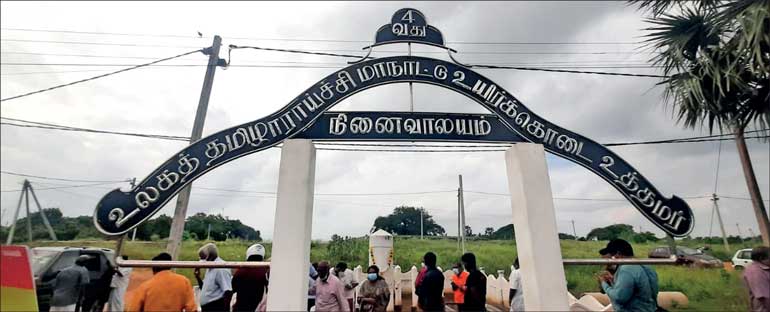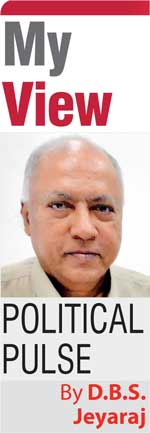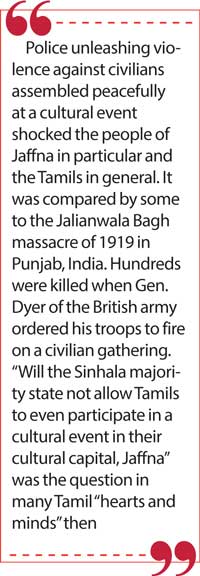Saturday Apr 19, 2025
Saturday Apr 19, 2025
Friday, 12 January 2024 00:30 - - {{hitsCtrl.values.hits}}

Commemoration of the death anniversary of the tragic victims
 A significant event in the post-independence history of the Sri Lankan Tamils took place 50 years ago on 10 January 1974 in Jaffna. A joyful cultural celebration was marred by the Sri Lankan Police unleashing violence against Tamil civilians. Ecstasy turned into agony when the panic-stricken people ran helter-skelter for safety. Seven persons died of electrocution when electric wires were dislodged by Police firing in the air. Another died of a heart attack in the melee. The 50th death anniversary of the tragic victims was commemorated in Jaffna on Wednesday
A significant event in the post-independence history of the Sri Lankan Tamils took place 50 years ago on 10 January 1974 in Jaffna. A joyful cultural celebration was marred by the Sri Lankan Police unleashing violence against Tamil civilians. Ecstasy turned into agony when the panic-stricken people ran helter-skelter for safety. Seven persons died of electrocution when electric wires were dislodged by Police firing in the air. Another died of a heart attack in the melee. The 50th death anniversary of the tragic victims was commemorated in Jaffna on Wednesday
(10 Jan.).
This columnist, then a 19-year-old, lived in Jaffna and attended the research conference related events. The course of events are yet embedded in memory. What happened then was this.
The fourth world Tamil Research Conference of the International Association of Tamil Research (IATR) was held in Jaffna from 3 to 9 January 1974. The conference attended by several internationally reputed Tamil scholars was purely academic and restricted to a selected audience. However a cultural event was held on 10 January for a mass audience with the participation of some of the international Tamil scholars. Several awards were handed out at the event. The huge crowd estimated between 10 and 15,000 spilled over into some streets and roads also.
A platform had been erected in the precincts of Veerasingham hall where the conference had taken place. The crowds attending the event were within Veerasingham hall premises and the Jaffna esplanade. The road between the hall and esplanade was full of people. Initially the Police cooperated fully with the organisers and even re-directed traffic along other roads to divert vehicles away from the crowds. The Police also ensured proper parking of vehicles. The Policemen on duty at the event had no problems with the people and even engaged in amiable conversation
with them.
ASP Chandrasekera
The atmosphere changed drastically when a Police contingent led by the then Assistant Superintendent of Police (ASP) Chandrasekera tried to proceed through the middle of the crowd and asked people through a hailer to move aside and let the Police vehicles pass. The people at the outer edges of the crowd did so and the vehicles proceeded inward slowly. Since the crowd in the middle was dense, the people could not move away and the Police vehicles got stuck. Some of the youngsters in the crowd began hooting and jeering.
ASP Chandrasekera a former bodyguard to the then Prime Minister Sirimavo Bandaranaike, then ordered his men to crack down forcefully although the Police had not sustained any damage or faced any real danger.
ASP Chandrasekera tried to justify his action later at the magisterial inquiry by stating that stones were thrown at the Police. He claimed that two Policemen were injured and a vehicle damaged by the stone throwing. The ASP also said that he was proceeding to the venue because of information that an Indian national and political activist from Tamil Nadu was addressing the meeting though he was not permitted to do so. The person in question was R. Janarthanam the president of the “Ulagath Thamizhar Ilaingar Paeravai” (World Tamil Youth Federation).
Acting under the ASP’s orders the Policemen numbering over 40 first began firing tear gas canisters. This was followed by helmet wearing cops baton charging the crowd. The terrified people began scattering and running in all directions seeking safety. Pandemonium erupted when the Police began using firearms by firing in the air.
Seven electrocuted
 The time was past 8 p.m. and additional electricity had been obtained through a generator to enhance illumination. When a Policeman fired upwards, some bullets hit the electric wires and loosened them. The overhead wires fell on an iron railing separating the Veerasingham hall and the road. As a result several people got electrocuted. Seven died. Apart from the deaths, over 50 people were injured in the stampede.
The time was past 8 p.m. and additional electricity had been obtained through a generator to enhance illumination. When a Policeman fired upwards, some bullets hit the electric wires and loosened them. The overhead wires fell on an iron railing separating the Veerasingham hall and the road. As a result several people got electrocuted. Seven died. Apart from the deaths, over 50 people were injured in the stampede.
In addition to the seven electrocuted, there was another casualty too on that night. This was a well-known school master who had died of a heart attack while fleeing the Police attack. There had also been two more deaths by electrocution the previous day. A parade with floats or vehicles with exhibits mounted on a platform was held on 9 January in Jaffna. One of the floats was a miniature replica of “Annapoorani” the Valvettithurai built schooner that was sailed to the USA. One of the sails struck overhead wires resulting in two men being electrocuted to death. Thus 10 persons had died in incidents relating to the Jaffna conference.
Police unleashing violence against civilians assembled peacefully at a cultural event shocked the people of Jaffna in particular and the Tamils in general. It was compared by some to the Jalianwala Bagh massacre of 1919 in Punjab, India. Hundreds were killed when Gen. Dyer of the British army ordered his troops to fire on a civilian gathering. “Will the Sinhala majority state not allow Tamils to even participate in a cultural event in their cultural capital, Jaffna” was the question in many Tamil “hearts and minds” then.
Tamil mood
The overwhelming Tamil mood was morose and resentful. While the Police attack was deplorable and by itself incurred the people’s wrath, there were two important reasons for the collective sense of hurt and grief felt by the Tamil people then.
The first was that the research conference had been held in Jaffna after a bitter struggle. Tamil politicians, academics, writers and artistes aligned with or sympathetic to the then United Front Government of Prime Minister Sirimavo Bandaranaike wanted the IATR conference to be held in Colombo. Another section of the Tamil people wanted it in Jaffna. Finally the conference was held in Jaffna despite the obstructionist tactics of the Government and their supporters. Jaffna in its entirety was in a festive mood then. Homage paid by foreign scholars to their mother tongue made all Tamils happy and proud. The unnecessary violence unleashed marred the joyful mood and caused anger and sadness.
The second reason was that the ruling Government showed no remorse or regret for the attack or the loss of life. Furthermore the Government turned a deaf ear to requests that the Government should set up a commission of inquiry to probe the incident. The matter was raised in Parliament too but there was only a deafening silence. The magisterial inquiry held by Jaffna magistrate K. Balakidnar had ruled that the deaths were due to “accidental electrocution”. But prevailing Tamil public opinion was for a commission of inquiry to probe the conduct of the Police.
Impact of incident
What must be realised is that the impact of an incident like this was tremendous five decades ago. It was like a first of its kind incident. Subsequently as the ethnic issue escalated into unbridled violence and open war, the Tamils experienced massacres of far greater proportion. But at that time seven persons dying as a result of Police violence had a profound effect on the Tamil psyche.
It was a crucial factor in strengthening the secessionist tendency among Tamils. It is noteworthy that former Leader of the Opposition and Tamil United Liberation Front (TULF) leader Appapillai Amirthalingam when testifying before the Sansoni Commission observed thus: “The refusal of the government to appoint a Presidential Commission to inquire into the seven deaths and the conduct of the Police which led to those deaths, was a prime cause of the demand for a separate state.”
IATR Conference
Tamils in Sri Lanka had looked forward to the IATR World Tamil Research Conference being held in Jaffna. Tamils are very proud of their ancient language and literature. Tamil is recognised as a classical language. A unique feature of the affectionate regard Tamils have for their language is the reference to “Thamizh Thaai” meaning mother Tamil. Tamils personify their mother tongue as their mother or mother Tamil. Hence an international Tamil conference being held in Jaffna was most welcome. In a land where their language had been deprived of official language status and where they had been systematically discriminated against, the honour and prestige of an international conference on Tamil in Jaffna was something they eagerly anticipated.
Fr. Thaninayagam
 Moreover Jaffna had a special link or connection with the IATR and the convening of Tamil research conferences. The IATR and Tamil research conferences was a brainchild of a distinguished Tamil from Jaffna. Rev Fr. Xavier Stanislaus Thaninayagam known respectfully as “Thaninayagam Adigal” was an eminent Catholic Clergyman and renowned linguistic scholar.
Moreover Jaffna had a special link or connection with the IATR and the convening of Tamil research conferences. The IATR and Tamil research conferences was a brainchild of a distinguished Tamil from Jaffna. Rev Fr. Xavier Stanislaus Thaninayagam known respectfully as “Thaninayagam Adigal” was an eminent Catholic Clergyman and renowned linguistic scholar.
Fr. Thaninayagam loved and revered the Tamil language. He taught at many universities and also lectured about the Tamil language, culture and literature globally visiting many countries. Thaninayagam Adigal also edited a quarterly journal called “Tamil Culture” specialising in Tamil studies.
Fr. Thaninayagam served as Dean of the Faculty of Arts and Head of the Indian Studies Department at the University of Malaya (UM) at Kuala Lumpur from 1961 to 1966. During this time, Fr. Thaninayagam participated at the 1964 Orient Scholars Conference in New Delhi. He along with two others convened a meeting of Tamil scholars attending the conference in New Delhi. Thaninayagam proposed the setting up of a body for Tamil studies and research. Thaninayagam’s brainchild became a reality in the form of the International Association for Tamil research (IATR) in New Delhi.
Kuala Lumpur
Xavier Thaninayagam followed through by organising the first world Tamil research conference under the auspices of the IATR in April 1966. It was held at the University of Malaya in Kuala Lumpur. The conference was ceremonially declared open by the Malaysian Prime Minister of that time Tunku Abdul Rahman. A total of 145 research papers were submitted.
Madras
The second IATR World Conference was held in the Indian city of Madras (now Chennai) in January 1968. It was declared open by the Indian President of that time Dr. Zakir Husain who was himself a leading educationist. 163 research papers were submitted. The strongly Tamil nationalist Dravida Munnetra Kazhagam (DMK) ruled the Tamil Nadu
state then.
The DNK chief minister CN Annadura’s Government popularised the academic conference by organising entertaining mass-oriented events simultaneously. Apart from a number of cultural events a gigantic procession followed by a mass meeting at Marina Beach was held. The icing on the cake was the erection of 10 statues of Tamil scholars, poets
and writers.
Paris
The third IATR World Tamil Conference was held in Paris in July 1970. Dr. Malcolm Adiseshiah a Tamil hailing from Vellore in Tamil Nadu was then the deputy director-general of UNESCO. Fr. Thaninayagam in tandem with Dr. Adiseshiah organised the conference in France. It was purely an academic affair. The conference was opened by the then French minister of culture Edmond Michelet. A total of 16 research papers were submitted. The then chief minister of Tamil Nadu, Muthuvel Karunanidhi attended the conference in Paris.
Sri Lanka venue
From inception, the IATR research conferences were held every two years. The fourth conference was scheduled to be held in 1972 and Sri Lanka was to be the venue. The Sirimavo Bandaranaike led Sri Lanka Freedom Party (SLFP) majority government was not receptive to the idea. It was said that the Tamil research conference would radicalise Tamil sentiments in Sri Lanka. It was also said that the leading Sri Lankan Tamil political party, the Ilankai Thamil Arasuk Katchi (ITAK) could politicise the event. Though the Leftist Lanka Sama Samaja Party (LSSP) and Communist Party (CP) were constituents of the Government, they did not enlighten their senior partner.
Chelliah Kumarasuriar
The only Tamil minister in the UF Government was Chelliah Kumarasuriar, an engineer, who held the post and telecommunications ministry portfolio. He had been first appointed Senator and after the abolition of the Senate made an appointed MP. A group of non-political Tamil academics and professionals interacted with Kumarasuriar and got his support to conduct the conference in Sri Lanka. Kumarasuriar in turn obtained the Government’s green light to hold the conference on the condition that it should only be of an academic nature devoid of politics.
The conference which should have been held in 1972 was not held that year. Finally it was scheduled for January 1974.
A committee was set up to organise the conference in Sri Lanka. It was widely representative and consisted of academics, professionals, artistes, writer and journalists. It was supposedly non-political and mandated to organise the conference only.
Colombo or Jaffna?
However the organising committee was soon divided internally. A bloc or group supportive of Kumarasuriar emerged. The primary bone of contention was the venue. Kumarasuriar and his group wanted it to be held in Colombo. The others with the tacit support of the ITAK wanted to be held
in Jaffna.
China’s gift to Sri Lanka the Bandaranaike Memorial International Conference Hall (BMICH) had been opened in Colombo. Kumarasuriar’s group wanted the Tamil conference to be held at the BMICH with the then President (Non-executive) William Gopallawa declaring it open. They argued that it was appropriate to hold the conference in the capital city Colombo. The first and third conferences were held in the Malaysian capital Kula Lumpur and French capital Paris, it was pointed out.
The others did not agree. They said the Tamil Conference should be held in the largest Tamil city in Sri Lanka – Jaffna. Moreover Jaffna was deemed the cultural capital of Sri Lankan Tamils. It was also pointed out that the second conference was held in the Tamil Nadu capital Madras and not New Delhi the Indian capital. After a long tussle the Pro-Jaffna sections in the Committee won the day.
The organising committee broke up and several resigned or were made to quit. Lake House Journalist T. Sabaratnam working for “Thinakaran” was a member of the organising committee. He voted for Jaffna as the venue. A furious Kumarasuriar exerted pressure on the ANCL management and forced Sabaratnam to resign from the committee. Retired Supreme Court Judge H.W. Thambiah was the committee head. He too resigned.
Prof. Vithianandan
A re-constituted organising committee was set up with Prof. Vithianandan as President.
Vithianandan had been the premier force in getting the conference to be held in Jaffna. The joint secretaries were Dr. Kopan Mahadeva and architect V.S. Thurairajah. A secretariat was set up in Main Street, Jaffna to organise the conference. Fr. Thaninayagam was the committee patron and adviser. The committee guaranteed that the conference would be purely academic and would not be
politicised.
The Government was not happy about the conference being held in Jaffna and was non-cooperative. Since the IATR Conference in Madras had been utilised by the ruling DMK to earn political kudos, it was feared that the ITAK would do so in Jaffna. Kumarasuriar and his minions especially the “Mutpoakku Ezhuthhaalar Sanfam” (Progressive Writers Association) and some Tamil academics were hostile. It was in this environment that the 4th IATR World Tamil Research Conference was held in Jaffna. What happened thereafter would be related in the second part of this article.
(The writer can be reached at [email protected].)